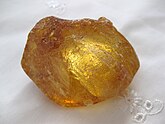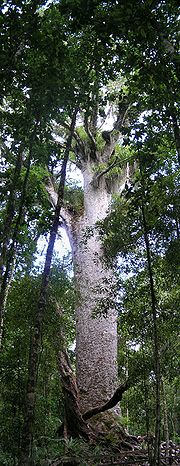Каури -жвачка

Каури -резинка является смолой от деревьев Каури ( Agathis Australis ), в которой исторически было несколько важных промышленных видов использования. Это также может быть использовано для изготовления ремесел, таких как ювелирные изделия. Леса Каури когда -то покрывали большую часть Северного острова Новой Зеландии, прежде чем ранние поселенцы заставили леса отступить, заставив несколько областей вернуться к сорнякам, скрабам и болотам . [ 1 ] Даже после этого древние поля Каури и остальные леса продолжали предоставлять источник для жвачки. [ 2 ] [ 3 ] В период с 1820 по 1900 год более 90% лесов Каури были зарегистрированы или сожжены европейцами. [ 4 ]
Каури -резинка образуется, когда смола от деревьев Каури протекает через переломы или трещины в коре, укрепляя при воздействии воздуха. Комочки обычно падают на землю и могут быть покрыты почвой и лесным мусором, в конечном итоге ископаемые . Другие комки образуются, когда ветви раздвоены или деревья повреждены, выпуская смолу. [ 5 ]
Использование
[ редактировать ]

было У маори много применений для жвачки, которую они называли Капией . Свежая резинка использовалась в качестве типа жевательной резинки (более старую жевательную резинку смягчена путем замачивания и смешивания с соком типографии пухи ). Высоковоспламеняющаяся резинка также использовалась в качестве пожарного старта или связана с льном , чтобы действовать как факел. Сгорев и смешанный с животным жиром, он сделал темный пигмент для татуировки Moko . [ 6 ] Каури -жвачка также была изготовлена в ювелирные изделия, на память и небольшие декоративные предметы. Как и янтарь , каури -резинка иногда включает насекомых и растительный материал. [ 7 ]
Каури -резинка использовалась в коммерческих целях в лаке и может рассматриваться как тип копала (название, данное смоле, используемой таким образом). Каури-резинка была особенно полезна для этого, и с середины 1840-х годов была экспортирована в Лондон и Америку. Предварительный экспорт начался несколькими годами ранее, для использования в морском клею и в качестве пожарных; [ 8 ] Уважника была частью экспортного груза в Австралию в 1814 году. [ 9 ]
Поскольку каури -резинка будет легче перемешать с льняным маслом при более низких температурах, к 1890 -м годам 70% всех масляных лаков, сделанных в Англии, использовали жевательную резинку каури. [ 10 ] Он использовался в ограниченной степени в красках в конце 19 -го века, а с 1910 года широко использовался в производстве линолеума . С 1930-х годов рынок жевательной резинки упал, когда были обнаружены синтетические альтернативы, но оставалось нишевое использование для жвачки в ювелирных изделиях и специализированном высококлассном лаке для скрипок . [10]
Kauri gum was Auckland's main export in the second half of the 19th century, sustaining much of the early growth of the city. Between 1850 and 1950, 450,000 tons of gum were exported.[11] The peak in the gum market was 1899, with 11,116 tons exported that year, with a value of £600,000 ($989,700 US).[9][12] The average annual export was over 5,000 tons, with the average price gained £63 ($103.91 US) per ton.[13]
Appearance
[edit]The gum varied in colour depending on the condition of the original tree. It also depended on where the gum had formed and how long it had been buried. Colours ranged from chalky-white through red-brown to black. The most prized was pale gold, as it was hard and translucent.[5][14] The size of each lump also varied greatly. Swamps tended to yield the small nuggets known as "chips", whereas hillsides tended to produce larger lumps. The majority were the size of acorns, although some were found which weighed a few pounds. The largest (and rarest) were reported to weigh half a hundredweight.[15] Kauri gum shares a few characteristics with amber, another fossilised resin found in the Northern Hemisphere. While amber can be millions of years old, carbon-dating suggests the age of most kauri gum is a few thousand years.[8]
Gumfields
[edit]
Most of the gumfields were in Northland, Coromandel and Auckland, the site of the original kauri forests. Initially, the gum was readily accessible, commonly found lying on the ground. Captain Cook reported the presence of resinous lumps on the beach at Mercury Bay, Coromandel, in 1769, although he suspected it came from the mangroves, and missionary Samuel Marsden spoke of their presence in Northland in 1819.[14]
By 1850, most of the surface gum had been harvested, and people began digging for it. The hillsides yielded shallow-buried gum (about 1 m), but in swamps and beaches it was buried much deeper (4 m or below).[2]
Gum-diggers
[edit]
Gum-diggers were men and women who dug for kauri gum in the old kauri fields of New Zealand at the end of the 19th and early 20th centuries. The term may be a source for the nickname "Digger" given to New Zealand soldiers in World War I.[16] In 1898, a gum-digger described "the life of a gum-digger" as "wretched, and one of the last [occupations] a man would take to."[17]
Gum-diggers worked in the old kauri fields, most of which were then covered by swamp or scrub, digging for gum. Much of the population was transient, moving from field to field, and they lived in rough huts or tents (which were called "whares", after the Maori for 'house'). It was extremely hard work and not well paid, but it attracted many Maori and European settlers, including women and children.[18] There were many Dalmatians, who had first come to work the South Island goldfields in the 1860s.[19] They were transient workers, rather than settlers, and much of their income was sent out of the country, resulting in resentment from the local workforce. In 1898, the "Kauri Gum Industry Act" was passed, which reserved gum-grounds for British subjects, and requiring all other diggers to be licensed. By 1910, only British subjects could hold gum-digging licences.[20]
Gum-digging was the major source of income for settlers in Northland, and farmers often worked the gumfields in the winter months to subsidise the poor income from their unbroken land. By the 1890s, 20,000 people were engaged in gum-digging, of which 7000 worked full-time.[21] Gum-digging was not restricted to settlers or workers in the rural areas; Auckland families would cross the Waitematā Harbour by ferry at weekends to dig in the fields around Birkenhead, causing damage to public roads and private farms, and leading to local council management of the problem.[22]
Methods
[edit]

Most gum was dug from the ground using gum-spears (pointed rods to probe for gum) and "skeltons", defined as blade-edged spades for cutting through old wood and roots as well as soil. Once the gum was retrieved it would need to be scraped and cleaned.[23]
Digging in swamps was more complicated. A longer spear (up to 8m) was often used, often fitted with a hooked end to scoop out the lumps. Scrub was often cleared first with fire; some became uncontrolled and swamp fires could burn for weeks.[24] Holes were often dug by teams in both hills and swamps—often up to 12m deep—and some wetlands were drained to aid in the excavation of gum.[25] As field gum became scarce, "bush gum" was obtained by purposely cutting the bark of kauri trees and returning months later to retrieve the hardened resin. Due to the damage caused to the trees by the cutting the practice was banned in state forests in 1905.[23] Gum chips, small lumps useful for the manufacture of linoleum, were difficult to find. By 1910, the process of washing and sieving to retrieve the chips became common. The process was later mechanised.[26]
Gum merchants
[edit]Gumdiggers generally sold their gum to local gumbuyers, who transported it to Auckland (generally by sea) for sale to merchants and exporters.[27] There were six major export firms in Auckland who dealt in gum, employing several hundred workers who graded and rescraped the gum for export, packing them in cases made from kauri timber.[28]
As early as the 1830s and 1840s, merchants, including Gilbert Mair and Logan Campbell, were buying gum from local Māori for £5 ($8.25) a ton or trading it for goods.[9] The majority of the gum was exported to America and London (from whence it was distributed throughout Europe), although smaller amounts were sent to Australia, Hong Kong, Japan and Russia.[29]
See also
[edit]Notes
[edit]- ^ Taonga, New Zealand Ministry for Culture and Heritage Te Manatu. "How and where kauri grows". teara.govt.nz. Retrieved 30 January 2023.
- ^ Jump up to: a b Hayward, pp 4–5
- ^ "Te Ara Encyclopedia of NZ: Kauri Forest". Teara.govt.nz. 1 March 2009. Retrieved 25 April 2011.
- ^ "In the forests of New Zealand, indigenous Maori and Western scientists work through past injustices to save a threatened species together". Ensia. Retrieved 30 January 2023.
- ^ Jump up to: a b Hayward, p 2
- ^ Hayward, p 3
- ^ "Category: kauri". Collections Online. Museum of New Zealand Te Papa Tongarewa. Retrieved 18 July 2010.
- ^ Jump up to: a b Gilbert Mair, 1843–1923 (1 March 2009). "Te Ara: The Encyclopedia of New Zealand: Origins and uses". Teara.govt.nz. Retrieved 25 April 2011.
{{cite web}}: CS1 maint: numeric names: authors list (link) - ^ Jump up to: a b c Hayward, p 46
- ^ Jump up to: a b Hayward, p 45
- ^ "Te Ara Encyclopedia of NZ: The Industry". Teara.govt.nz. 2 March 2009. Retrieved 25 April 2011.
- ^ Dunmore, p 21
- ^ Reed, p 114
- ^ Jump up to: a b "Encyclopedia of NZ, 1966: Kauri Gum". Teara.govt.nz. 22 April 2009. Retrieved 25 April 2011.
- ^ Reed, p 20
- ^ Te Ara: The Encyclopedia of New Zealand: The New Zealanders
- ^ recorded in Appendices to the Journals of the House of Representatives, 1898, H–12, p. 31, and quoted in Te Ara Encyclopedia of NZ
- ^ Te Ara: The Encyclopedia of New Zealand: Gumdigging
- ^ Te Ara Encyclopedia of NZ: Damaltians
- ^ Те Ара Энциклопедия Новой Зеландии: Далматинцы: Gumdiggers
- ^ Хейворд, стр. 47
- ^ МакКлюр, стр. 55-6
- ^ Jump up to: а беременный TE - энциклопедия Новой Зеландии: методы речь
- ^ Хейворд, стр. 10–11
- ^ Хейворд, стр. 12–13
- ^ Хейворд, стр. 27
- ^ Хейворд, P 19
- ^ Хейворд, стр. 42–43
- ^ Хейворд, стр. 44
Ссылки
[ редактировать ]- Хейворд, Брюс В. (1982). Каури -резинка и гумдиггеры: живописная история индустрии каури в Новой Зеландии . Окленд : Lodestar Press. ISBN 0-86465-014-0
- МакКлюр, Маргарет (1987). История Биркенхеда . Окленд: городской совет Биркенхеда. ISBN 0-908704-04-6
- Рид, Альфред (1972). Gumdiggers: история каури -жвачки . Окленд: Ах и Ау Рид . ISBN 0-589-00772-7
- Данмор, Патриция (ред.) (1977). Dunmore Book of New Zealand Records . Веллингтон : Dunmore Press. ISBN 0-908564-08-2
Внешние ссылки
[ редактировать ]- Те Ара, энциклопедия Новой Зеландии
- История копателей
- Музей Каури архивировал 15 декабря 2007 года на машине Wayback